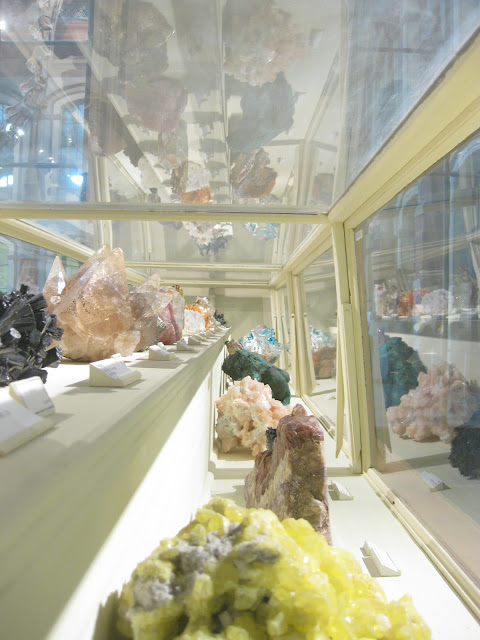and cool treats (spaghetti eis):
I also stopped by the natural history museum (museum für naturkunde) to check out dinosaurs and stuff:
To my delight this museum had an AMAZING collection of crystals. As my friends checked out the dinosaur fossils and taxidermied hippos and stuff, I spent the rest of the day looking at case upon case of wicked crystals:
I'll start with the second-best set of crystals in their collection, these amazing cubes of iron pyrite (FeS2) embedded in a rock. This is some science-fiction-type-shit that I still cannot believe exists, not to mention that it somehow forms naturally. Look at those cubes! The crystals' macroscopic cubic shape reflects the nanoscopic cubic pattern into which the iron and sulfur atoms pack themselves in iron pyrite.
The museum also had an awesome set of gypsum crystals (CaSO4·2H2O). After grinding to a powder and heating the crap out of that powder, gypsum is used as the primary ingredient in drywall.
The colors were plentiful in this room, and perhaps the most shocking was the malachite (Cu2CO3(OH)2) that looked like it had an azurite (Cu3(CO3)2(OH)2) acne problem. These two are related copper minerals that differ only in the proportions of their carbonate and hydroxide ions, which as you can see, has huge ramifications for how the crystals look.
My niece, a big fan of pink, would probably be into these rhodochrosite (MnCO3) crystals:
Finally, the only crystal shown here that is also a pure chemical element, sulfur (S). This stuff is used in various forms everywhere, on fields as a fertilizer, on the ends of sticks as part of matches, in our bodies as part of amino acids (cysteine), and the list goes on... plus it looks so cool!
Aesthetic reasons aside, I think crystals are cool because of how pure they are. I mean pure in the sense that each crystal is generally made up of one specific chemical. How did these pure chemicals come to exist?
And let's finish with the most awesome crystals on the planet, which can be found in the Naica Mine in Chihuahua, Mexico. That's right, those are people walking around on enormous crystals. They are crystals of selenite (a type of gypsum), some as large as 4 feet in diameter and 50 feet long. INSANE.
More pictures of the Naica mine crystals are available here, and here is a cool video snippet about the cave. I want to go to there.
Finally, because I couldn't figure out another place to put it, I left it here at the end for you hardcore nerds out there. Why are all these crystals different colors?? WTF?
Like most other things, the answer all has to do with electrons. Those are the things that end up absorbing/reflecting the light that hits the crystals, and in doing so they change the composition of the light that hits our eyes, leading to awesome colors. The way the electrons interact with the light depends on how they can move around in the crystal, which in turn is constrained by the configurations and types of atoms that make up the crystals. Finally, the configuration and composition of the crystals is dictated by the environment in which they formed (hot, cold, high pressure, low pressure, available elements, etc), which is pretty complex. For more on electrons moving in crystals, check out this awesome blog post from Gravity and Levity.
Like most other things, the answer all has to do with electrons. Those are the things that end up absorbing/reflecting the light that hits the crystals, and in doing so they change the composition of the light that hits our eyes, leading to awesome colors. The way the electrons interact with the light depends on how they can move around in the crystal, which in turn is constrained by the configurations and types of atoms that make up the crystals. Finally, the configuration and composition of the crystals is dictated by the environment in which they formed (hot, cold, high pressure, low pressure, available elements, etc), which is pretty complex. For more on electrons moving in crystals, check out this awesome blog post from Gravity and Levity.











